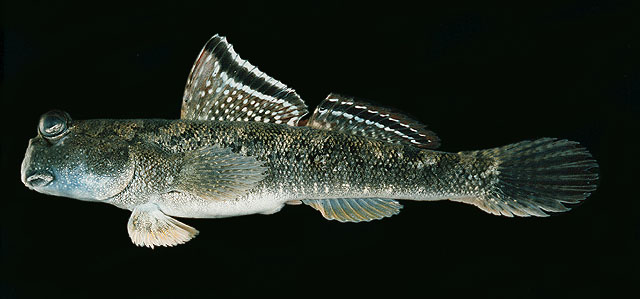|
Periophthalmus argentilineatus Valenciennes, 1837 Barred mudskipper |

|
|
photo by
Randall, J.E. |
| Family: | Oxudercidae (Mudskippers), subfamily: Periophthalminae | |||
| Max. size: | 19 cm TL (male/unsexed) | |||
| Environment: | reef-associated; freshwater; brackish; marine; depth range 0 - 1 m, amphidromous | |||
| Distribution: | Indo-Pacific: along East African coast, from Zululand in South Africa northwards to the Red Sea and most of West Indian Ocean islands (Ref. 4756); further east to the Marianas and Samoa; north to Ryukyu Islands, south to western Australia and Oceania (Ref. 2334). | |||
| Diagnosis: |
Dorsal spines (total): 12-18; Dorsal soft rays (total): 9-12; Anal spines: 1-1; Anal soft rays: 8-11. Diagnosis: Distinguished by the following characteristics: pelvic fins lacking frenum; little or no membrane uniting medial most pelvic rays; first dorsal fin height moderate, its margin usually convex, occasionally straight, with a black stripe inframarginally and numerous small, white spots posteriorly on fin, no elongate spines; second dorsal fin with single, dusky stripe mesially; dorsal fins not connected by membrane; first dorsal fin with 11-16 spines; longitudinal scale count 64-100; head width 14.3-22.6% of standard length; pelvic fin length 11.3-15.2% of standard length; length of anal fin base 14.0-19.4% of standard length; length of second dorsal-fin base 17.6-23.7% of standard length; total D2 elements 10-13; total anal fin elements 9-12; TRDB 18-26 (Ref. 5218). Description: First dorsal fin with 10-17 spines, second dorsal fin with 1 spine and 10 soft rays; anal fin with 1 spine and 8-11 soft rays; pectoral fin with 11-14 rays; first dorsal fin and second dorsal fin contiguous (Ref. 2798, 5218). Colouration: Dusky; both dorsal fins with white margin and black stripe below (Ref. 2798). |
|||
| Biology: | A resident intertidal species with homing behavior (Ref. 32612, 48637) and amphibious air-breather (Ref. 31184, 79840), found in brackish mud flats in mangrove and nipa palm areas. Found in both littoral and estuarine; able to climb out of water, in mangrove swamps and burrowing into intertidal mud banks (Ref. 4756). Occasionally in the lower parts of freshwater streams (Ref. 2847, 44894, 48637, 79840). Actively shuttling back and forth between rock pools and air (Ref. 31184). It feeds on worms, crustaceans, and insects (Ref. 37816). Can stay out of the water for up to 37 h if kept moist (Ref. 51276). | |||
| IUCN Red List Status: | Least Concern (LC); Date assessed: 20 June 2017 Ref. (130435) | |||
| Threat to humans: | harmless | |||